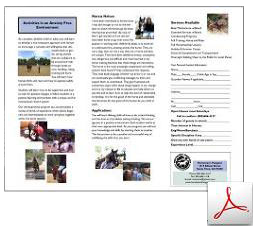 Transitioning to Barefoot Care
Transitioning to Barefoot Care
I am considering having my horse transition from shoes to barefoot. Can I have you come over or me trailer to your place and see if you think he is a candidate? What is the pricing and interval of trimming at the beginning and over the longer term?
Marcia's Answer:
Regarding shoes, yes, I'd be happy to come over and see your horse and give some input on his potential as a barefoot horse. There are a lot of factors that go into it. If you can shoot me answers to questions below it would help me to respond more specifically to your horse.
Is he in shoes because it is the normal thing to do or is he in shoes because of problems?
How long have you had him and what has been his history?
How long has he been in shoes?
Has he ever had time off from them, like a month or two to breathe etc?
Is he in 2 or 4 shoes? If in 2 how do his back feet wear barefoot?
Is he prone to thrush?
Who is doing his shoes now?
Has he had abscesses? Is he prone to them?
What is his diet? What kind of hay and how often? Any other supplements?
Any health issues?
What does he do for a living?
What kind of terrain?
All of these factors will help in knowing even before I see his feet. And will help me once I do see them to make a better educated opinion. He could be the kind that walks off barefoot and goes fine. He could need boots or he could need casts. The cast idea is awesome and is working for a number of my clients with barefoot horses. It is literally like the kind of cast that goes on a broken bone with people but designed with horses in mind. It bands the hoof wall and also goes under the foot and gives great protection while the foot transitions out of having the elevated shoe under the hoof wall only. It allows the sole and hoof wall to work together on a closer plain together with protection as it's adjusting and it also takes away the problem of the weight of the horse putting downward pressure on the laminae before the laminae have a chance to strengthen up without the shoe holding the hoof wall in place.
The horse with healthy laminae and hoof wall and enough sole thickness is a great barefoot horse. All of it can be achieved with careful management and maintenance based on the specific horse's needs.
Muddy weather means that the casts have extra challenges to stay put, but I can double cast them to help them last. 2-4 weeks are about the max we get. They're not cheap but while they are on they are maintenance free. Boots work too and if you don't need the solid banding effect that the casts do they're awesome. Boots need to be monitored for rubs and to empty out mud and dirt.
If your horse lives on a hill and that is combined with the rain and mud could mean that casts won't work for now. They might, but the more they get jostled around the less likely the glue will stick long enough to make them work. It's like food settling in containers with a lot of shaking and motion in transit. It really changes by the time we get it off the shelf! Do you have access to a smaller flat paddock for transition time?
The questions is, how long is transition time? It can range from none to a few weeks or months to a year depending on answers to the questions above. With boots or casts, you ride them right on through it all. Barefoot horses in transition need to be checked far more often than the every 6 week situation with shoes routine. Their inner structures shift and reposition as they correct themselves and tweaking the outer hoof will help it to go where it needs for the best positioning possible for them. The hoof will tell us what the inner structures want and it's important to monitor it.
A horse with contracted feet due to the unforgiving nature of shoes can experience abscesses when the tissues have circulation returned to them and older dead tissues die off and new healthy tissue grows in. It is not an every horse occurrence, but it can happen.
This is a lot of info but there is a lot as an owner to know and you want to be able to make the best decision you can for your pal and buddy!!
I can give you some costs associated to the process once I have answers to these questions and have an idea of how complex it might be for him. I've had plenty of them walk out and never look back but I've also had those that were high maintenance to make it happen.
I have concluded that it is always a good thing for them to have a breather from shoes even if it is only for part of the year. I've never regretted pulling shoes. I'm always a fan of doing anything that will improve the overall heath of my horses even if it does mean extra work. It's worth it for them. Timing is a factor especially if they are trail distance horses. And I mean competitive distance horses that go on heavy duty trail terrain for 25 to 50+ miles a day.
Most casual trail riding can work through the transition time with casts or boots if needed. The more serious trail competitor may want to begin the transition during the off season and then use boots if needed for competition. Garrett Ford, owner of Easy Care Inc., rode his horse in Easy Boot Glue On boots to a top-10 finish in the Tevis Cup 100 miles in one day competition and won the coveted Haggin Cup for best condition.
Marcia Nelson
Santa Ynez, CA
www.horsemanshangout.com
www.pacifichoofcare.org
(805) 448-5724


